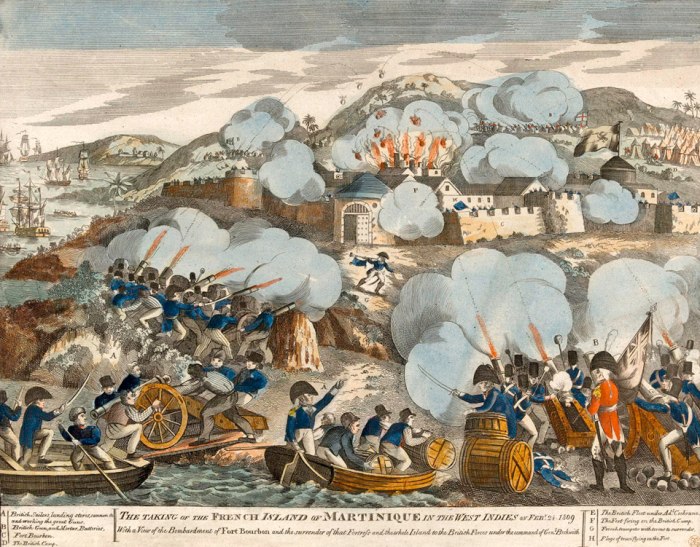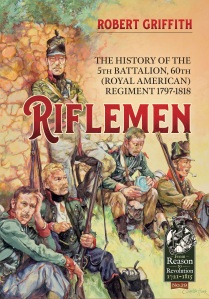
The popular perception is that ordinary soldiers being commissioned from the ranks in the early 19th Century was very rare, but during my research for ‘Riflemen’ I found that it was actually quite common. Almost every sergeant major of the 5th Battalion of the 60th Regiment was eventually commissioned as an ensign, and there were usually two or three officers in the mess that had been NCOs.
All these officers then took the next step up and gained promotion to lieutenant, but further advancement was harder to achieve. Only one was promoted further than captain, and he rose to lieutenant colonel and the command a regiment.
Gotfried Starck entered British Service in 1795, aged just 16, and joined Lowenstein’s Chasseurs, a light infantry and rifle-armed regiment raised by the Prince of Lowenstein-Wertheim to fight against France. Starck had risen to sergeant by the time the 5/60th was formed from Lowenstein’s Chasseurs and Lowenstein’s Fusiliers, on Barbados in December 1797. The 5/60th became the first all rifle-armed battalion in the regular British Army. A little under two years later Starck was sergeant major. He was still only 20 years old. To be the senior sergeant of the battalion and in charge of men perhaps twice his age he must have not only been a highly competent soldier, but also have had considerable physical and command presence. After a year as sergeant major he was promoted from the ranks and commissioned as an ensign in October 1800. Like many foreign officers of the time he chose to anglicise his name and became known as Godfrey.
Three years later, just after the battalion had been posted to Halifax, Nova Scotia, he was promoted to lieutenant, and in 1804 he was appointed adjutant. The adjutant was a role often given to officers from the ranks. They would assist the commanding officer, do most of the administrative tasks, and take a lead role in both discipline and training. In February 1807, after the battalion had returned to the UK, Starck was promoted to captain in the Royal African Corps.
The corps was a ‘condemned battalion’ made up of criminals and deserters sentenced to service in the colonies, often for life. In August 1807 the Royal African Corps was divided into two regiments; the Royal York Rangers, sailed for the West Indies from its base in Guernsey, while the Royal African Corps remained in the British colonies on its eponymous continent. Starck went to the Caribbean with the Royal York Rangers.
The Rangers must have been a difficult unit to mould into an effective fighting force, consisting as it did of men with little left to lose, but they seemed to have achieved an excellent reputation. They were part of the British force that took Martinique in January 1809 and in April the Rangers, along with the rifle companies of the 3rd and 4th Battalions of the 60th and elements of the 3rd and 8th West India Regiments, were involved in an action on the Les Saintes islands near Guadeloupe:
‘On the night of the 15th, a strong picquet of the enemy was surprised by two companies of the Royal York Rangers, commanded by Captain Starke [sic] and Lieutenant White. The French had one officer and seventeen men bayonetted, and twelve prisoners were brought away. This affair was highly creditable to the officers named.’1
The Rangers and the rest of the force went on to defeat the French and take possession of the islands. In January 1810 they were again in action, this time on Guadeloupe. On 5 February the Rangers (commanded by Major Henderson) in a small brigade under Brigadier Wale was ordered to force a crossing of the de la Pere river. Wale’s dispatch included:
‘The pass of the river De la Pere was by nature most difficult, and was made still more by abbattis lined with troops, and every possible obstruction thrown in our way. Here it was the enemy first opened the fire of musketry; but our brave troops, superior to all difficulties, soon forced this passage. Having passed the river, we continued our march, for about 100 yards, through rugged rocks and bushes, when the front companies branched off into three columns, rapidly ascending the heights, the three leading companies reserving their fire till they gained the same; the remainder firing to their flanks on the enemy, but still following the van. As we approached the summit of the height, the ascent became more difficult, and about 500 of the enemy’s best troops poured down on us a most destructive fire.
Major Henderson, with the three companies who first ascended the heights, found the enemy posted behind abbattis and stockaded redoubts. This intrepid officer did not return the fire of the enemy till within about twenty-five yards distance, and immediately closed with them; it was about one hour and a half from our being first engaged with the enemy, after the passage of the river, to their complete dispersion; during which time it was impossible for troops to shew more cool and undaunted courage, than was exhibited upon that occasion by that gallant regiment the Royal York Rangers, to every individual of which I feel highly indebted for the success of the day; and as your excellency was an eye-witness to the difficulties they surmounted, I need not say more upon the subject, and when all behaved well, it would be invidious to distinguish particular merit. Major Henderson was wounded and disabled from further service by a ball in the breast, in close contact with the enemy. Being myself afterwards disabled, the command would have devolved upon that gallant officer Captain Stark, had he not, with Captain Darling, also been wounded about the same time.’2
Starck recovered and was promoted to major in 1812 and then lieutenant colonel in 1815, both without purchase. Guadeloupe was returned to the French in 1814 when Napoleon was defeated and forced into exile on Elba. When Napoleon escaped and regained power in 1815 the news was slow to reach the colonies in the West Indies. After some indecision, the governor of Guadeloupe declared for the Emperor on 18 June, the same day as Napoleon’s defeat at Waterloo.
The Rangers were part of a hastily formed expedition under Lieutenant General Sir James Leith that sailed to assault the island in late July, before news of Napoleon’s defeat had arrived. The Rangers, 850 strong and now commanded by Starck, landed on 8 August at Saint Sauveur to counter a force of 500 French moving to join the main enemy force. Starck then had orders to drive the French back from several positions to the rear and flank of the enemy troops readied to oppose the main British landing. In a series of actions the remainder of the British troops managed to defeat the French and force them to surrender. Leith’s dispatch noted that:
‘Lieutenant Colonel Starck conducted the service entrusted to him with intelligence and gallantry.’3
The taking of Guadeloupe was the last battle of the Napoleonic Wars. Lieutenant Colonel Godfrey Starck retired from the army in 1817 after 22 years service.
1 T. Southey, Chronological History of the West Indies. Vol. III, pp. 462.
2 T. Southey, Chronological History of the West Indies. Vol. III, pp. 485.
3 The Gazette, 18 September 1815, Issue 17062, pp. 1911.

My history of the 5/60th – Riflemen is available now from Amazon.com, Amazon.co.uk and other book retailers, or direct from the publisher Helion & Co.